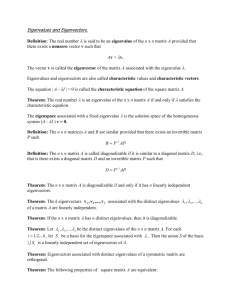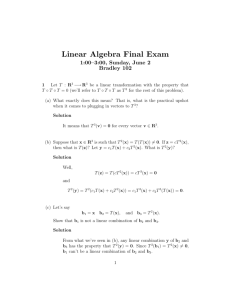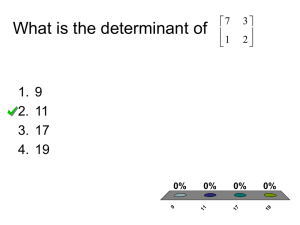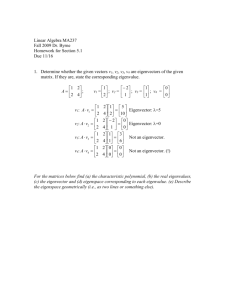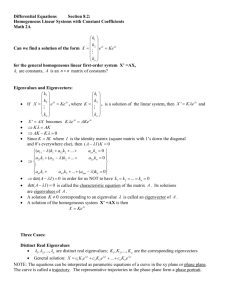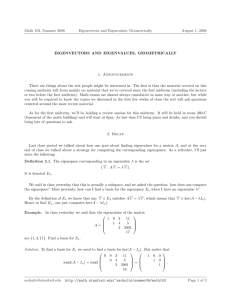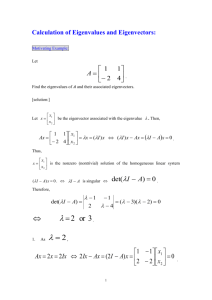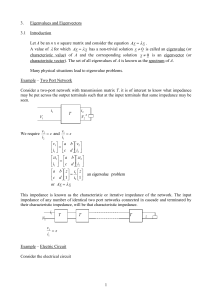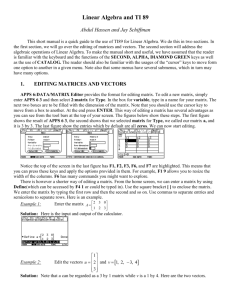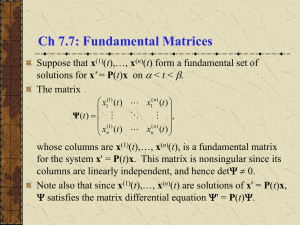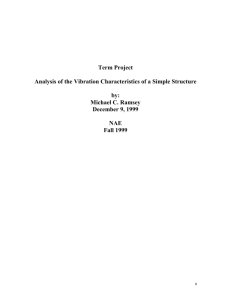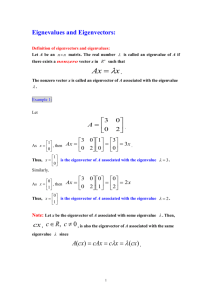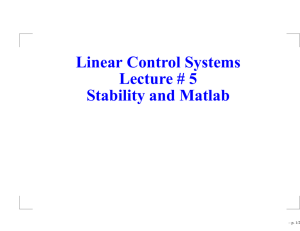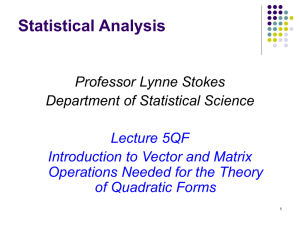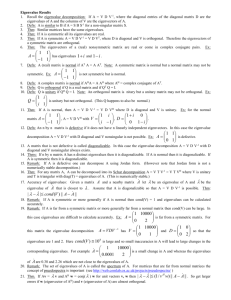Chap 5 Slides
advertisement
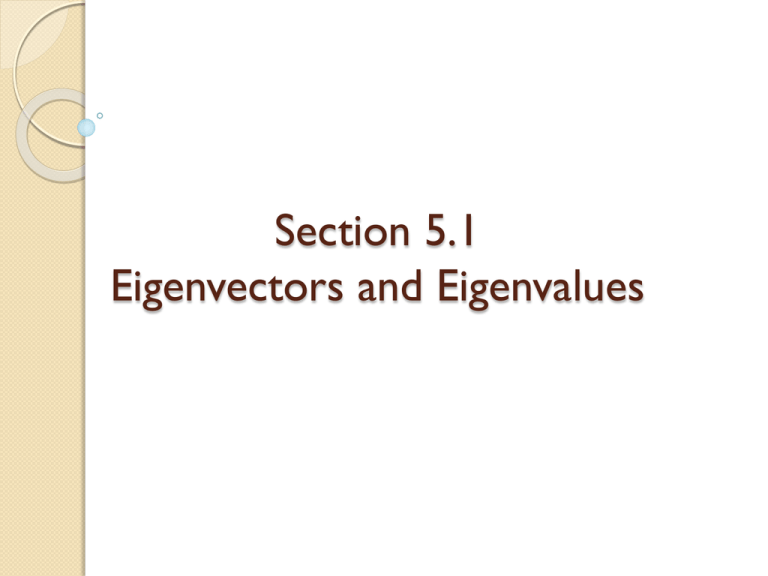
Section 5.1
Eigenvectors and Eigenvalues
Eigenvectors and Eigenvalues
•Useful
throughout pure and applied mathematics.
•Used to study difference equations and continuous
dynamical systems.
•Provide critical information in engineering design
•Arise naturally in such fields as physics and chemistry.
•Used in statistics to analyze multicollinearity
Example:
3 3
•Let A
1 5
•Consider
3
v1
1
Av for some v
1
v2
1
1
v3
1
Definition:
•The
Eigenvector of Anxn is a nonzero vector x such that
Ax=λx for some scalar λ.
•λ
is called an Eigenvalue of A
Statistics (multicollinearity)
yi 0 1 x1 2 x2 ....... i xi i
•Where
y is the dependent response vector and the x’s
are the independent explanatory vectors
•The β’s are least squares regression coefficients
•εi are errors
•We desire linear independence between x vectors
•Can use Eigen analysis to determine
From Definition:
•Ax
= λx = λIx
•Ax – λIx = 0
•(A – λI)x = 0
•Observations:
1.
2.
3.
λ is an eigenvalue of A iff (A – λI)x= 0 has non-trivial
solutions
A – λI is not invertible
IMT all false
The set {xεRn: (A – λI)x= 0} is the nullspace of (A – λI)x=
0, A a subspace of Rn
The set of all solutions is called the eigenspace of A
corresponding to λ
Example
Show that 2 is an eigenvalue of
3 3
A
1
5
and find the corresponding eigenvectors.
Comments:
Warning:The method just used (row reduction) to
find eigenvectors cannot be used to find
eigenvalues.
Note: The set of all solutions to (A-λI)x =0 is called
the eigenspace of A corresponding to λ.
Example
Let
1 2 2
A 3 2 1
0 1 1
An eigenvalue of A is λ=3. Find a basis for the
corresponding eigenspace.
Theorem
The eigenvalues of a triangular matrix
are the entries on its main diagonal.
Proof of 3x3 case
a11
Let A 0
0
a12
a22
0
a13
a23
a33
a11
So (A-λI) = A 0
0
a12
a22
0
a11
0
0
a13 0 0
a23 0 0
a33 0 0
a12
a22
0
a13
a23
a33
Proof of 3x3 case
By definition λ is an eigenvalue iff (A-λI)x=0
has non-trivial solutions so a free variable must
exist.
a11
0
0
a12
a22
0
a13
a23
a33
This occurs when a11=λ or a22=λ or a33=λ
Example
Consider the lower triangular matrix below.
4 0 0
A 0 0 0
1 0 3
λ= 4 or 0 or -3
Addtion to IMT
Anxn is invertible iff
s. The number 0 is not an eigenvalue
t. det A≠0 (not sure why author waits until
not to add this)
Theorem
If eigenvectors have distinct
eigenvalues then the eigenvectors
are linearly independent
This can be proven by the IMT
Section 5.2
The Characteristic Equation
Finding Eigenvalues
1.
We know (A-λI)x=0 must have nontrivial solutions and x is non-zero. That
is free variables exist.
2.
So (A-λI) is not invertible by the IMT
3.
Therefore det(A-λI)=0 by IMT
Characteristic Equation
det(A-λI)=0
Solve to find eigenvalues
Note: det(A-λI) is the characteristic polynomial.
Previous Example:
•Let
3 3
A
1 5
find eigenvalues
Example
Find Eigenvalues
1 2 1
A 0 5 0
1 8 1
Example
Find characteristic polynomial and eigenvalues
3 2 3
A 0 6 10
0 0 2
Example
a.
b.
c.
Find the characteristic polynomial
Find all eigenvalues
Find multiplicity of each eigenvalue
2
5
A
9
1
0
3
1
2
0 0
0 0
3 0
5 1
Recap
a.
b.
c.
λ is an eigenvalue of A if (A-λI)x=0 has non-trivial
solutions (free variables exist).
Eigenvectors (eigenspace )are found by row reducing
(A-λI)x=0.
Eigenvalues are found by solving det(A-λI)=0.
Section 5.3
Diagonalization
Diagonalization
•The
goal here is to develop a useful
factorization A=PDP-1, when A is nxn.
•We can use this to compute Ak quickly for
large k.
•The matrix D is a diagonal matrix (i.e.
entries off the main diagonal are all zeros).
Example
Find a formula for Ak given A=PDP-1 &
6 1
A
2 3
1 1
P
1
2
5 0
D
0 4
2 1
P
1 1
1
Diagonalizable
Matrix “A” is diagonalizable if
A=PDP-1 where P is invertible
and D is a diagonal matrix.
Note: AP=PD
When is a matrix diagonalizable?
Let’s examine eigenvalues and eigenvectors
of A
6 1
A
2 3
The Diagonalization Theorem
If Anxn & has n linearly independent
eigenvectors.
Then
1.
A=PDP-1
2.
Columns of P are eigenvectors
3.
Diagonals of D are eigenvalues.
Example
Diagonalize
2 0 0
A 1 2 1
1 0 1
We need to find P & D
Theorem
If Anxn has n distinct eigenvalues then A is
diagonalizable.
Example
Diagonalize
2 4 6
A 0 2 2
0 0 4
Example
Diagonalize
2 0 0
A 2 6 0
3 2 1




